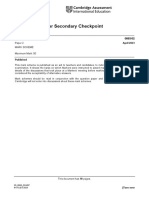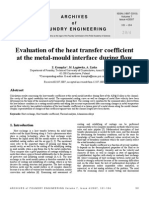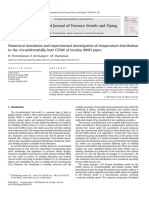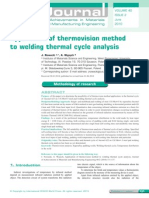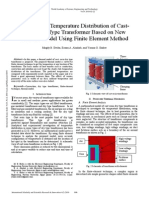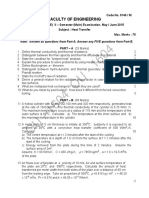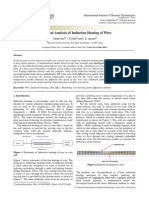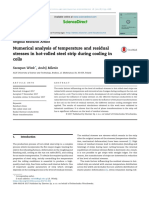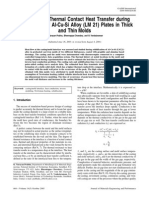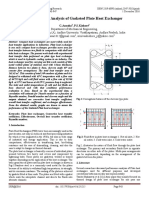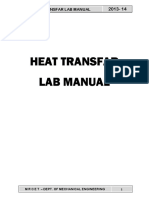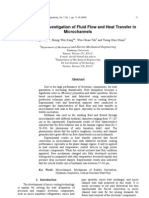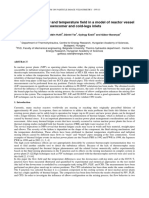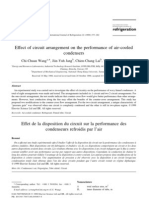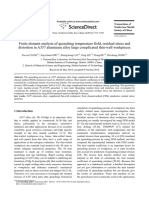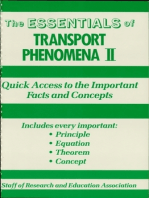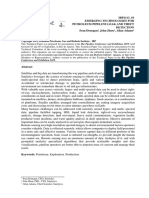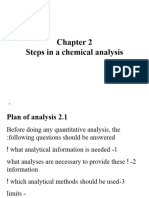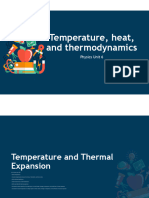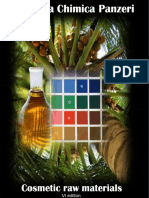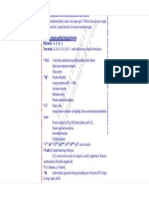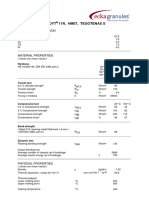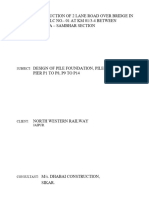Fe Analysis of Temperature Field of PQF Mandrel: Xinwen Li, Yanfeng Tu, Yun Guo
Fe Analysis of Temperature Field of PQF Mandrel: Xinwen Li, Yanfeng Tu, Yun Guo
Uploaded by
Marcelo Varejão CasarinCopyright:
Available Formats
Fe Analysis of Temperature Field of PQF Mandrel: Xinwen Li, Yanfeng Tu, Yun Guo
Fe Analysis of Temperature Field of PQF Mandrel: Xinwen Li, Yanfeng Tu, Yun Guo
Uploaded by
Marcelo Varejão CasarinOriginal Title
Copyright
Available Formats
Share this document
Did you find this document useful?
Is this content inappropriate?
Copyright:
Available Formats
Fe Analysis of Temperature Field of PQF Mandrel: Xinwen Li, Yanfeng Tu, Yun Guo
Fe Analysis of Temperature Field of PQF Mandrel: Xinwen Li, Yanfeng Tu, Yun Guo
Uploaded by
Marcelo Varejão CasarinCopyright:
Available Formats
Proceedings of the 2012 9th International Pipeline Conference IPC2012 September 24-28, 2012, Calgary, Alberta, Canada
IPC2012-90209
FE ANALYSIS OF TEMPERATURE FIELD OF PQF MANDREL
Xinwen Li1, Yanfeng Tu, Yun Guo Tube Pipe and Bar Business Unit, Baoshan Iron & steel Co., LTD Shanghai 201900, China 1 Contact Author Rmin Minimum diameter of roll; ti Deformation time, which means the duration time of the workpiece in the ith stand; tm Deformation temperature; ven Entrance velocity; vex Exit velocity; Deformation degree; & Deformation rate; Equivalent deformation degree(e); Elongation percentage of pass; Resistance of deformation; Equivalent stress, which s or can substitute for. INTRODUCTION Since A.H Calmes obtained the MPM continuous rolling tube patent in 1968, there has been a 43-year development history of the retained-mandrel continuous-rolling mill, which falls into two important periods - the 2-roll continuous-rolling process (MPM) period and 3-roll continuous-rolling process (Premium Quality Finishing, PQF) period. To further improve the quality of steel pipe, i.e., dimensional accuracy and surface quality, Tianjin Pipe Company, together with German SMS Meer and Italy INNSE, designed the worlds first PQF[1] and put it into commissioning in August 2003. This newlydeveloped longitudinal rolling mill, which adopts the retained mandrel technology, consists of a series of adjustable, driven, 3 roll type stands. Its uniform deformation in the 3 roll pass satisfies the needs of the tube plants greatly in tube quality, productivity and production cost. Current research on PQF is few, and the majority is on the deformation of the capillary tube. Vincenzo Palma, et al [2, 3] analyzed the cross-section shape of deformed tube in MPM and PQF through the finite element method (FEM). Fengshan Du, et al [4] simulated the deformation process and change regularity of wall thickness by the 3D elastic-plastic FEM. However, there were few papers relevant to other important parameters in PQF rolling process, such as temperature. The
KEY WORDS Temperature field, PQF, Finite element method, Mandrel ABSTRACT The PQF (Premium Quality Finishing) tube mill has been the most technologically advanced continuous-rolling tube mill so far. The mandrel is one of the main tools for processing in PQF, the temperature distribution and variation of which is the basis of studying the abrasion and defect generation of mandrels. Finite element method is applied to obtain the temperature field of every phase and the temperature history in PQF rolling tube 28CrMo57. The results show that the surface nodes are always in high temperature while the temperature of internal nodes almost maintains original value; the surface temperature of the mandrel changes dramatically, and the temperature reduction rate reaches 160/s between the 1# stand and the 2# stand; the average temperature of the whole mandrel rises fastest in the 1# stand, whereas the rate of rise slows down considerably in the subsequent phases. After comprehensive consideration of simulation results and failure mechanism of the mandrel, some suggestions on prolonging mandrel life are presented. Key words: temperature field, PQF, finite element method, mandrel NOMENCLATURE D0 Nominal diameter of roll; d0 Tube external diameter before rolling; dk Tube external diameter after rolling; F1 Cross sectional area after rolling; F0 Cross sectional area before rolling;
h0 Wall thickness before rolling; hk Wall thickness after rolling; K1 Efficiency of transforming plastic deformation work to heat; n Rotational speed of roll; q Heat generation rate;
Copyright 2012 by ASME
temperature field and thermal stress field are the investigation basis of the thermal fatigue of the roll, and they are important for prolonging the life of the roll and improving the surface quality and the shape of the workpiece [5]. In this paper the FEM is applied to doing thermal-structure coupled analysis of PQF Mandrel on the existing general software platform. As a result, the temperature field and the temperature history of the mandrel at every stage of the PQF rolling process are obtained, which are the theoretical basis for analyzing defect generation of the mandrel and quality problems of the internal surface of capillary tube. ANALYTICAL CONDITION Model Establishment and Meshing The schematic drawing of PQF pass is shown in Figure 1.
The temperature field of the mandrel and the capillary tube in the deformation zone of the 1# stand of PQF is assumed as the initial temperature field, and the field is admitted to be approximately uniform. According to the actual datum from the plant, before the mandrel piercing, its temperature is about 80, and the temperature of the capillary tube is about 1050.
Capillary tube
Mandrel
FIGURE 2 GEOMETRICAL MODEL AND MESHING In the plastic deformation zone, rolls contact the capillary tube mutually and the capillary tube contacts the mandrel mutually, so heat conducts between each other. After many factors being taken into account, it is assumed that there is no heat transfer between rolls and the capillary tube and that the mandrel and the capillary tube contact close with heat conducting thoroughly. Between stands, there are heat convection and thermal radiation between the surface of the capillary tube and air; there is heat conduction between the capillary tube and the mandrel. In the whole PQF rolling process, the surface temperature of the capillary tube maintains above 800 basically; consequently, the surface thermal radiation dominates heat transfer. The emissivity of various stages is considered to be 0.8[6], and the environment temperature is considered to be the room temperature 20. In rolling process, the plastic deformation work will cause the temperature of the workpiece to rise. K1 is assumed to be 0.9, and the heat generation rate q can be calculated by the following formula [7]: (1) ti F (2) = e = ln 0 = ln F1 The expression [8] for resistance of deformation of the tube material 28CrMo57 is shown in Equation (3).
FIGURE 1 SCHEMATIC DRAWING OF PQF PASS Since there is close relationship of temperature change between the capillary tube and the mandrel for their mutual contact and on account of boundary conditions and various stages of result transmission of temperature field, 3D geometrical model of the capillary tube and the mandrel is employed, in which the element type of the external surface of the capillary tube is SURF152 and the element type of others is SOLID7. The meshing of the deformation zone in the 1# stand of PQF is shown in Figure 2. There are 28900 elements and 31850 nodes in the mandrel, and 9824 elements and 9984 nodes in the tube. The models of the later phases are similar to it, but the shape is somewhat different. Due to result succession of the previous phase, the number of elements and nodes keeps constant. Initial and Boundary Condition
q = K1
= 165 [1 .368 (
] 0 .4 tm & t ( 0.258 1000 0.170 ) ( ) exp( 2 .712 m + 2 .746 ) 10 1000 0 .4
) 0.293 0 .368
(3)
Copyright 2012 by ASME
The calculated heat generation rate q is listed in Table 1.
TABLE 1 HEAT GENERATION RATE 1# 2# 3# 4# 74~78 74~78 74~78 62~68 21 19 18 18 19 18 18 18 1.8 1.2 0.9 0.7 1.2 0. 9 0.7 0.8 61 62 62 51 63.53 92.51 113.56 168.03 1050.00 998.81 978.67 944.98 1.429 1.381 1.242 1.113 133 190 263 327 191 264 327 364 0.0680 0.0215 0.0132 0.0046 1450 4297 4938 6738
according to load type, as shown in Table 4. TABLE 3 ENTHALPY AND SPECIFIC HEAT CAPACITY OF TUBE MATERIAL 28CrMo57
Temperature () 364 533 688 774 800 1132 Enthalpy (kJkg-1) 188.27 296.78 408.82 536.19 524.03 748.45 Specific heat capacity ( Jkg-1-1) 629 789 926 935 756 777
Stand D0(mm) d0(mm) dk(mm) h0(mm) hk(mm) Rmin(mm) n(rmin-1) tm() ven(mms-1) vex(mms-1) ti(s) q (Wm-3)
5 62~68 18 18 0.7 0.8 51 170.69 1.016 364 370 0 0
TABLE 4 DESCRIPTION OF EVERY PHASE DURING PQF ROLLING
Phase 1 2 3 4 5 6 7 8 9 Brief description First pass Air-cooling process between 1#stand and 2#stand Second pass Air-cooling process between 2#stand and 3#stand Third pass Air-cooling process between 3#stand and 4#stand Fourth pass Air-cooling process between 4#stand and 5#stand Mandrel extracting process between 5#stand and extractor Duration(s) 0.068 0.613 0.022 0.330 0.013 0.358 0.005 0.239 17.010
Enthalpy is taken into account to calculate heat increment generated by phase transition. It is supposed that plastic deformation of the deformation zone is uniform in the rolling process, and generated heat loads every node of the tube evenly at various deformation stages. It is postulated that the heat increment generated by friction has offset the heat loss caused by heat conduction between the capillary tube and rolls. Material Thermophysical Parameters The mandrel material 4Cr5MoSiV1 refers the chromium steel (wCr5%) [9], and the tube material is 28CrMo57 [10]. Their thermophysical parameters are shown in Table 2 and Table 3. Density and specific heat capacity are tested at room temperature 20 and thermal conductivity changes with the temperature. TABLE 2 MATERIAL THERMOPHYSICAL PARAMETERS
Density( kgm-3) Specific heat capacity( Jkg-1-1) Temperature/ 0 100 200 300 400 600 800 1000 1200 Mandrel 7830 460 36.3 35.2 34.7 33.5 31.4 28.0 27.2 27.2 27.2 Tube 7857 50.1 51.4 44.7 30.7 38.8 42.7
Thermal conductivity ( Wm-1-1)
As the geometry and load of every phase are different from one another, it is essential to model and load separately in every phase; in accordance with the chronological order of rolling, the next model inherits the result of the previous model as initial condition. The whole process, which is from mandrel penetration to mandrel taking off, is divided into 9 phases
RESULTS AND DISCUSSION The comparison of calculated values and experimental data are shown in Figure 3. While validating simulation results, the calculated temperature average of the overall nodes of the tube external surface is 1029 after rolling, whose deviation is 1.97% compared with the field temperature 1050; as for the mandrel, the calculated average of the overall nodes of its surface is 645 after the extraction of the mandrel, whose deviation is 0.80% compared with the field temperature 650; the calculated temperature average of all tube nodes is 931 after rolling, within production experience value(over 900). In conclusion, the simulation results are safe and reliable. The comparison of both values is shown in Figure 3. In the figure, A stands for temperature average of the overall nodes of the tube external surface after rolling, B temperature average of the overall mandrel nodes after the extraction of the mandrel and C temperature average of all tube nodes after rolling. Figure 4 shows the final temperature field of the mandrel and the capillary tube after mandrel extracting. For perfect rolling technology of PQF, the shape of finished tubes is approximately cylindrical. Figure 5 reveals the temperature change curve with the distance from the center. The following discussions can be derived from the simulation results.
Copyright 2012 by ASME
1000
Calculated Result Field Value
800
600
400
200
0 A B C
Item Symbol
FIGURE 3 VALIDATION OF SIMULATION RESULTS
FIGURE 4 FINAL TEMPERATURE FIELD OF MANDREL AND CAPILLARY TUBE
800
600
400
200
0 0 20 40 60 80 100
Distance from center/mm
FIGURE 5 TEMPERATURE VERSUS DISTANCE FROM CENTER
(1) The temperature gradient of mandrel cross section is great; after penetration, the mandrel contacts the capillary tube, and the temperature of the surface nodes soars to rather high temperature, and keeps high level in the consequent process; in PQF rolling, the temperature of every internal sample point changes little, exactly speaking, the temperature of every sample point in the position of 3/4 of mandrel radius only rises by 3.1, and that within this position almost maintains 80; in mandrel extracting process, owing to a long period of time, the temperature of the sample points in the position of 3/4 of mandrel radius increases more than twice, that in the position of 1/2 of mandrel radius rises by 37, and that within the position of 1/2 of mandrel radius nearly keeps 80. (2) There is steep change of temperature in the surface of the mandrel; its temperature rises sharply after its penetration; then with intense heat conduction between the cold mandrel, its temperature declines steeply and the rate is the largest in aircooling process between 1# stand and 2# stand, the value of which is 160/s; the average of temperature decline rate in PQF rolling process is 122/s; as mandrel extraction, the temperature field become uniform gradually, the decline rate decreases and its value is 8/s or so; finally its value drops to about 645. (3) The average temperature of the whole mandrel rises fastest in the first pass; in the following phases, the rate of rise slows down considerably, the value of which is 26/s between 1# stand and 2# stand and just 6/s in mandrel extraction. (4) The main influencing factor on the temperature of the mandrel is the heat conduction between the mandrel and the capillary tube, while the impact of the heat conduction between rolls and the capillary tube, thermal radiation and internal heat source is negligible. Generally, surface cracking and mechanical scratch are the main failure modes of the mandrel. Surface cracking results from thermal fatigue-the body of the mandrel endures large temperature stress owing to dramatic temperature change of the environment. The deformation of PQF rolling is uniform, so there are fewer rolling defects caused by mechanical injury and more defects caused by thermal fatigue. In PQF rolling process, the mandrel extrudes the internal surface of the capillary tube and rolls extrude the external surface of the capillary tube, which makes the tube billets deform and lets the mandrel standing tensile extrusion and thermal shock. At the beginning, for the mandrel is at low temperature, its lubrication and strength is preferable; after contacting the hot tube, its surface temperature increases dramatically; but after finishing rolling, its surface temperature decreases dramatically for injection water cooling. Therefore, the mandrel surface bears sharp thermal cycling. In the entire process, the temperature gradient of the mandrel section is large, so the thermal expansion of different parts mismatches, leading to high thermal stress; repeated changes for a long time make the forming of chaps, leading to the failure of the mandrel. However, the depth affected by heat is little, and the distribution will become uniform in cross-
Temperature/
Temperature/
Copyright 2012 by ASME
section direction after a few seconds when the mandrel is plugged out of the pipe. It is easy for the mandrel to wear or form defects because that the friction coefficient of the mandrel surface increases quickly after the mandrel contacting the tube and that meanwhile the mechanical properties of the mandrel deteriorates immediately. Since the plasticity of the mandrel increases with increasing of the temperature as it is heated during PQF rolling, the notch sensitivity or stress-concentration sensitivity will decrease; thus abrasion and damage caused by deformation occur before fatigue breakdown. The following recommendations for extending mandrel life are made after comprehensive analysis of simulation results and failure mechanism of the mandrel: (1) Make the temperature of the mandrel uniform, thus its thermal stress will reduce; strengthen preheating system of the mandrel and control the cooling of the mandrel; before production, preheat mandrels of strictly matched group uniformly in the preheat furnace and cool mandrels timely after production. (2) Enhance the dynamic use system of mandrels; adjust the number and the use rhythm of a group of mandrels, and use more mandrels appropriately when the equipment is in good condition and fast-paced production so as to avoid the temperature increment and performance deterioration; isothermal mandrels of equal diameter are put into team use in time. (3) Raise the retained speed of mandrels reasonably; for being mainly taken into account the quality of the inner surface of the finished tube, the retained speed of mandrels is fixed in 970mm/s; it is increasing the retained speed that can reduce the generated friction heat and control the temperature increment so as to reduce thermal load, but that wont outweigh the drawbacks of high retained speed, such as machining difficulty and cost of long mandrels. Nowadays the high-speed retained mandrels are employed, which speed is approximately equal to the entrance speed of the 1# stand, or larger than it by 10% or so. (4) Strengthen the mandrel lubrication system to guarantee that the mandrel has a good finish and that generated friction heat decreases. (5) Choose mandrel material of excellent heat conduction property so as to reduce generation of thermal stress. (6) Adopt the hollow mandrel, in order to improve the temperature uniformity and the cooling rate after using of the mandrel. CONCLUSIONS (1) There is the great temperature gradient in mandrel cross section; in PQF rolling process, the temperature of the mandrel surface nodes is always high and the temperature of every internal sample point almost keeps constant. The surface temperature of the mandrel changes sharply; after its penetration, the temperature rises rapidly; afterwards there is steep temperature decline whose rate is the largest in air-
cooling process between the 1# stand and the 2# stand and its value is 160/s. There is the largest rise rate of the average temperature of the whole mandrel in the 1# stand; however, the value drops to 26/s between 1# stand and 2# stand. (2) The causes of short life of the mandrel are analyzed and rational advices are proposed for prolonging mandrel life: strengthen preheating system of the mandrel and dominate the cooling of the mandrel; set the reasonable dynamic use system of mandrels; adopt high-speed retained mandrel; intensify the mandrel lubrication system; select mandrel material of excellent heat conduction property. (3) Indirect judgment of the thermal stress field is obtained through the temperature field; nevertheless, further work will be devoted to analyzing precise distribution of thermal stress, which combines the rolling force and the stress field of the capillary tube to comprehensively analyze the abrasion and defect generation of the mandrel.
REFERENCES [1] Theelen Norbert, Rinaldi Patricio, and Zesheng Yan, 2005, Top technology for seamless steel tube production at Tianjin, Tube International, Vol. 28, pp. 20-27. [2] Palma Vincenzo, Bandini Stefano, and Pehle Hans Joachim, 1999, The PQF mill (Premium Quality Finishing) -the ultimate process for high quality seamless tube production, 41st MWSP CONF.PROC.. Warrendale, USA, pp. 585-595. [3] Palma Vincenzo, Bandini Stefano, and Pehle Hans Joachim, 2000, The premium quality finishing mill the ultimate process for high quality seamless tube production, Tube International, Vol. 29, pp. 253-257. [4] Fengshan Du, Qingtian Zhou, and Jian Wu, 1998, Computer Simulation of 3-roll Continual Tube Rolling PQF, Iron and Steel, Vol. 33, pp. 35-37. [5] Changsheng Li, Hailiang Yu, and Guanyu Deng, 2007, Numerical simulation of temperature field and thermal stress field of work roll during hot strip rolling, Journal of Iron and Steel International, Vol. 14, pp.18-21. [6] Xianghua Liu, 1994, Rigid-plastic Finite Element Method and Its Application in Rolling, Metallurgical Industry Press, Beijing, China, pp. 89-101. [7] Lianshi Li, 1985, Principle of Steel Pipe Plastic Deformation(A), Metallurgical Industry Press, Beijing, China, pp. 155-167. [8] Xiuhua Gao, Wei Liu, and Kemin Qi, 2006, Study on Deformation Resistance of 28CrMo57 Steel, Steel Pipe, Vol.35, pp. 21-25.
Copyright 2012 by ASME
[9] Shiming Yang, and Wenquan Tao, 1998, Heat Transfer, Higher Education Press, Beijing, China, pp. 53-54. [10] Wei Liu, 2005, Technological Modification and Check of
Equipment Parameters for 250mm MPM, Masters Degree Thesis, Northeastern University, Shenyang, China.
Copyright 2012 by ASME
You might also like
- Past Papers CheckpointDocument18 pagesPast Papers CheckpointHarini Bharani100% (15)
- Optimization of Shell and Tube Heat ExchangerDocument29 pagesOptimization of Shell and Tube Heat ExchangerAna QuintanaNo ratings yet
- Evaluation of The Heat Transfer Coefficient at The Metal-Mould Interface During FlowDocument4 pagesEvaluation of The Heat Transfer Coefficient at The Metal-Mould Interface During FloweidelsayedNo ratings yet
- Twisted Tape and Wire Coil InsertsDocument6 pagesTwisted Tape and Wire Coil InsertsAntoni MacierewiczNo ratings yet
- To Study of Parametric Analysis of Shell and Tube Heat ExchengerDocument9 pagesTo Study of Parametric Analysis of Shell and Tube Heat ExchengerManish PrajapatiNo ratings yet
- Heat Transfer and Turbulent Flow Friction in A Circular Tube Fitted With Conical-Nozzle TurbulatorsDocument11 pagesHeat Transfer and Turbulent Flow Friction in A Circular Tube Fitted With Conical-Nozzle TurbulatorsAnonymous 7BQxlt8cNo ratings yet
- HT Lab Manual FinalDocument58 pagesHT Lab Manual Finalsharadesh sarnaikNo ratings yet
- Gtaw of 800hDocument9 pagesGtaw of 800hpradeepNo ratings yet
- A Finite Element Analysis For The Least Temperature Rise in A Hot Torsion Test SpecimenDocument14 pagesA Finite Element Analysis For The Least Temperature Rise in A Hot Torsion Test SpecimenkotakamalsNo ratings yet
- Application of Thermovision MethodDocument7 pagesApplication of Thermovision MethodWilly Villa SalsavilcaNo ratings yet
- Simulation and Control of The Cooling of Hot Rolled Steel Wire RodDocument8 pagesSimulation and Control of The Cooling of Hot Rolled Steel Wire RodmirellespindolaNo ratings yet
- Steady State Temperature Distribution of Cast Resin Dry Type Transformer Based On New Thermal Model Using Finite Element MethodDocument5 pagesSteady State Temperature Distribution of Cast Resin Dry Type Transformer Based On New Thermal Model Using Finite Element MethodAnonymous sAmJfcVNo ratings yet
- Experiment No.2: Date: 30-08-2023Document4 pagesExperiment No.2: Date: 30-08-2023navneetservNo ratings yet
- Transient Temperature Distribution in A Steel Rod Subjected To Friction WeldingDocument11 pagesTransient Temperature Distribution in A Steel Rod Subjected To Friction WeldingMuhammad Fatka FirmansyahNo ratings yet
- CFD Analysis of Cylindrical Pin With Trapezoidal Fin Heat Sink Using ANSYS Fluent 14.0Document8 pagesCFD Analysis of Cylindrical Pin With Trapezoidal Fin Heat Sink Using ANSYS Fluent 14.0Nithin GowdaNo ratings yet
- Heat Transfer Ou Paper 2015Document2 pagesHeat Transfer Ou Paper 2015ARZeeshanNo ratings yet
- Heat Transfer Coefficients of Shell and Coiled Tube Heat ExchangersDocument5 pagesHeat Transfer Coefficients of Shell and Coiled Tube Heat ExchangersShalehAhmad100% (1)
- Numerical Analysis of Induction Heating of Wire: Research ArticleDocument7 pagesNumerical Analysis of Induction Heating of Wire: Research ArticleJosé Hernández BarrientosNo ratings yet
- Numerical Simulation of Sleeve Repair Welding On In-Service 16Mn Crude Oil PipelinesDocument5 pagesNumerical Simulation of Sleeve Repair Welding On In-Service 16Mn Crude Oil PipelinesjangdiniNo ratings yet
- Fallsem2016-17 4628 RM001 Mee303 ElaDocument57 pagesFallsem2016-17 4628 RM001 Mee303 ElamansurNo ratings yet
- Numerical Analysis of Temperature and Residual Stresses in Hot-Rolled Steel Strip During Cooling in CoilsDocument10 pagesNumerical Analysis of Temperature and Residual Stresses in Hot-Rolled Steel Strip During Cooling in CoilsFahrgerusteNo ratings yet
- Mathematical Modelling of Steel QuenchingDocument6 pagesMathematical Modelling of Steel Quenchingmanashree02No ratings yet
- Experiment No.01 Title: Thermal Conductivity of Insulating PowderDocument6 pagesExperiment No.01 Title: Thermal Conductivity of Insulating PowderPrathmesh JamodeNo ratings yet
- Study On A PCM Heat Storage System For Rapid Heat Supply: Jinjia Wei, Yasuo Kawaguchi, Satoshi Hirano, Hiromi TakeuchiDocument18 pagesStudy On A PCM Heat Storage System For Rapid Heat Supply: Jinjia Wei, Yasuo Kawaguchi, Satoshi Hirano, Hiromi TakeuchiResearcherzNo ratings yet
- Numerical Simulation of Titanium Alloy Machining in Electric Discharge Machining ProcessDocument6 pagesNumerical Simulation of Titanium Alloy Machining in Electric Discharge Machining Processchiru1431No ratings yet
- CFD Analysis of An Elliptical Pin Fin Heat Sink Using Ansys Fluent v12.1Document8 pagesCFD Analysis of An Elliptical Pin Fin Heat Sink Using Ansys Fluent v12.1Kelsey RyanNo ratings yet
- Casting-Mold Thermal Contact Heat Transfer During Solidification of Al-Cu-Si Alloy (LM21) Plates in Thick and Thin MoldsDocument6 pagesCasting-Mold Thermal Contact Heat Transfer During Solidification of Al-Cu-Si Alloy (LM21) Plates in Thick and Thin MoldsJinsoo KimNo ratings yet
- Heat Transfer Lab ManualDocument44 pagesHeat Transfer Lab ManualNaveen luckyNo ratings yet
- Liu2004 PDFDocument9 pagesLiu2004 PDFLỢI NGUYỄN CÔNGNo ratings yet
- Experimental and Numerical Investigation For Structural and Thermal Characteristics of Externally Finned Double Pipe Heat ExchangerDocument7 pagesExperimental and Numerical Investigation For Structural and Thermal Characteristics of Externally Finned Double Pipe Heat ExchangerInternational Journal of Application or Innovation in Engineering & ManagementNo ratings yet
- 943-947 Ijer - 2016 - 1231 Guttula Anusha CDocument6 pages943-947 Ijer - 2016 - 1231 Guttula Anusha CInnovative Research PublicationsNo ratings yet
- Unit IIIDocument8 pagesUnit IIIPrashant NandanNo ratings yet
- J Cep 2017 08 014Document24 pagesJ Cep 2017 08 014Dr. Raed GateaNo ratings yet
- Microsoft Word - HT LAB MANUAL - Doc 2013-14 PDFDocument74 pagesMicrosoft Word - HT LAB MANUAL - Doc 2013-14 PDFbhulakshmideviNo ratings yet
- Analysis of Helical Coil Heat Exchangers: by V.Swapna Priya Guide R S MauryaDocument23 pagesAnalysis of Helical Coil Heat Exchangers: by V.Swapna Priya Guide R S MauryaSwapna Priya VattemNo ratings yet
- 2Document12 pages2Thabang Maphakisa0% (1)
- Experimental Investigation of Fluid Flow and Heat Transfer in MicrochannelsDocument6 pagesExperimental Investigation of Fluid Flow and Heat Transfer in MicrochannelsRam MurtyNo ratings yet
- Tep Lab Lab Report Experiment # 01: Study of Linear Heat Conduction Through Aluminium and Stainless-Steel BarDocument11 pagesTep Lab Lab Report Experiment # 01: Study of Linear Heat Conduction Through Aluminium and Stainless-Steel BarMehndi DesignsNo ratings yet
- Effect of V-Shape Twisted Jaw Turbulators On Thermal Performance of Tube Heat Exchanger: An Experimental StudyDocument7 pagesEffect of V-Shape Twisted Jaw Turbulators On Thermal Performance of Tube Heat Exchanger: An Experimental Studymustafa11dahamNo ratings yet
- Calculation and Analysis of Temperature Distribution in Hot Rolling StripDocument11 pagesCalculation and Analysis of Temperature Distribution in Hot Rolling StripBorislav FilipovNo ratings yet
- Chapter 5 - Heat ExchangerDocument48 pagesChapter 5 - Heat ExchangerHoneydaa FitraNo ratings yet
- Rasouli Yazdi1998Document11 pagesRasouli Yazdi1998Antonio Alonso Diaz ArriagaNo ratings yet
- Effectiveness Improvement of Shell and Tube Type Heat ExchangerDocument5 pagesEffectiveness Improvement of Shell and Tube Type Heat ExchangerAditya ManideepNo ratings yet
- A025 PaperDocument9 pagesA025 PaperkkkprotNo ratings yet
- Mathematical Modeling of Copper and Brass UpcastingDocument24 pagesMathematical Modeling of Copper and Brass UpcastingMoreno MarcatiNo ratings yet
- 20-21 Eme Lab 21eme FinalDocument38 pages20-21 Eme Lab 21eme FinalAditya DiwanNo ratings yet
- CronfaDocument20 pagesCronfaKassya SchunkNo ratings yet
- Lab ManualDocument57 pagesLab ManualFawziyyah AgboolaNo ratings yet
- An Engineering Model of Coils and Heat Exchangers For HVAC System Simulation and OptimizationDocument6 pagesAn Engineering Model of Coils and Heat Exchangers For HVAC System Simulation and Optimizationsilentsoldier781344No ratings yet
- (ME-2505) Lab 1Document9 pages(ME-2505) Lab 1Ruman Hossain RonyNo ratings yet
- Yang 2018Document8 pagesYang 2018Fajar Haris Fauzi fajarharis.2019No ratings yet
- Heat Transfer Augmentation in Round Tube With DiamDocument8 pagesHeat Transfer Augmentation in Round Tube With DiamDarius PavriNo ratings yet
- Effect of Circuit Arrangement On The Performance of Air-Cooled CondensersDocument8 pagesEffect of Circuit Arrangement On The Performance of Air-Cooled Condensersaliscribd46No ratings yet
- 3D Modelling of A Multi Pass Dissimilar Tube Welding and Post Weld Heat Treatment of Nickel Based Alloy and Chromium SteelDocument7 pages3D Modelling of A Multi Pass Dissimilar Tube Welding and Post Weld Heat Treatment of Nickel Based Alloy and Chromium Steelkaliappan45490No ratings yet
- Siemens 1 GTX 100 TurbineDocument16 pagesSiemens 1 GTX 100 Turbinejparmar100% (1)
- Ay1011sem1 Me3122eDocument3 pagesAy1011sem1 Me3122eCammy MiunoNo ratings yet
- Experiment of HTDocument41 pagesExperiment of HTRonak ModiNo ratings yet
- Yang 2013Document10 pagesYang 2013mohamadNo ratings yet
- IBP1146 - 19 Maintenance Productivity Measurement Study at TranspetroDocument8 pagesIBP1146 - 19 Maintenance Productivity Measurement Study at TranspetroMarcelo Varejão CasarinNo ratings yet
- IBP1142 - 19 Offshore Development: Submarine Pipelines-Soil InteractionDocument13 pagesIBP1142 - 19 Offshore Development: Submarine Pipelines-Soil InteractionMarcelo Varejão CasarinNo ratings yet
- IBP1141 - 19 The Use of Optical Sensor To Investigate Dissolved Oxygen in CrudeDocument12 pagesIBP1141 - 19 The Use of Optical Sensor To Investigate Dissolved Oxygen in CrudeMarcelo Varejão CasarinNo ratings yet
- IBP1128 - 19 In-Service Welding Hot Tap of Refinary Pipeline With Hydrogen and EthyleneDocument10 pagesIBP1128 - 19 In-Service Welding Hot Tap of Refinary Pipeline With Hydrogen and EthyleneMarcelo Varejão CasarinNo ratings yet
- Riopipeline2019 1138 Rio Paper Rev01 PDFDocument11 pagesRiopipeline2019 1138 Rio Paper Rev01 PDFMarcelo Varejão CasarinNo ratings yet
- Riopipeline2019 1124 Worlds First Remote Deepwater PDFDocument10 pagesRiopipeline2019 1124 Worlds First Remote Deepwater PDFMarcelo Varejão CasarinNo ratings yet
- Riopipeline2019 1127 Article Number Ibp1127 19 PDFDocument10 pagesRiopipeline2019 1127 Article Number Ibp1127 19 PDFMarcelo Varejão CasarinNo ratings yet
- Riopipeline2019 1140 Ibp 1140 Nao Intrusivos Final PDFDocument4 pagesRiopipeline2019 1140 Ibp 1140 Nao Intrusivos Final PDFMarcelo Varejão CasarinNo ratings yet
- Riopipeline2019 1135 Riopipeline2019 t1135 JST Av1Document8 pagesRiopipeline2019 1135 Riopipeline2019 t1135 JST Av1Marcelo Varejão CasarinNo ratings yet
- Riopipeline2019 1121 201906051235ibp1121 19 Final PDFDocument8 pagesRiopipeline2019 1121 201906051235ibp1121 19 Final PDFMarcelo Varejão CasarinNo ratings yet
- Riopipeline2019 1137 201906031307ibp1137 19 Increas PDFDocument10 pagesRiopipeline2019 1137 201906031307ibp1137 19 Increas PDFMarcelo Varejão CasarinNo ratings yet
- IBP1123 - 19 Caliper Ili Experience in Offshore Pre-CommissioningDocument10 pagesIBP1123 - 19 Caliper Ili Experience in Offshore Pre-CommissioningMarcelo Varejão CasarinNo ratings yet
- Riopipeline2019 1126 Article Number Ibp1126 19 PDFDocument11 pagesRiopipeline2019 1126 Article Number Ibp1126 19 PDFMarcelo Varejão CasarinNo ratings yet
- Riopipeline2019 1120 Ibp1120 19 Transpetro S Worklo PDFDocument9 pagesRiopipeline2019 1120 Ibp1120 19 Transpetro S Worklo PDFMarcelo Varejão CasarinNo ratings yet
- Riopipeline2019 1112 FM 1112 FinalDocument10 pagesRiopipeline2019 1112 FM 1112 FinalMarcelo Varejão CasarinNo ratings yet
- Riopipeline2019 1117 Ibp1117 19 Versao Final para e PDFDocument8 pagesRiopipeline2019 1117 Ibp1117 19 Versao Final para e PDFMarcelo Varejão CasarinNo ratings yet
- IBP1099 - 19 Deep Water Pip Installation Using Reel-Lay MethodDocument12 pagesIBP1099 - 19 Deep Water Pip Installation Using Reel-Lay MethodMarcelo Varejão CasarinNo ratings yet
- IBP1111 - 19 Best Alternative For Rigid Offshore Pipelines Decommissioning - A Case StudyDocument13 pagesIBP1111 - 19 Best Alternative For Rigid Offshore Pipelines Decommissioning - A Case StudyMarcelo Varejão CasarinNo ratings yet
- IBP1119 - 19 Internal Corrosion Detection: Conference and Exhibition 2019Document4 pagesIBP1119 - 19 Internal Corrosion Detection: Conference and Exhibition 2019Marcelo Varejão CasarinNo ratings yet
- IBP1122 - 19 High Grade Sawl Linepipe Manufacturing and Field Weld Simulation For Harsh EnvironmentsDocument11 pagesIBP1122 - 19 High Grade Sawl Linepipe Manufacturing and Field Weld Simulation For Harsh EnvironmentsMarcelo Varejão CasarinNo ratings yet
- IBP1110 - 19 The Relevance of Fuel Transmission Pipelines in BrazilDocument10 pagesIBP1110 - 19 The Relevance of Fuel Transmission Pipelines in BrazilMarcelo Varejão CasarinNo ratings yet
- Riopipeline2019 1113 201906031824ibp Riopipeline 11 PDFDocument10 pagesRiopipeline2019 1113 201906031824ibp Riopipeline 11 PDFMarcelo Varejão CasarinNo ratings yet
- Riopipeline2019 1107 201905201751ibp1107 19 Jacques PDFDocument7 pagesRiopipeline2019 1107 201905201751ibp1107 19 Jacques PDFMarcelo Varejão CasarinNo ratings yet
- Riopipeline2019 1093 201905221205final Paper Overpi PDFDocument12 pagesRiopipeline2019 1093 201905221205final Paper Overpi PDFMarcelo Varejão Casarin100% (1)
- IBP 1102 - 19 A Gas Routing Identification System On A Pipeline NetworkDocument12 pagesIBP 1102 - 19 A Gas Routing Identification System On A Pipeline NetworkMarcelo Varejão CasarinNo ratings yet
- IBP1101 - 19 Element Simulations and Offshore ObservationsDocument13 pagesIBP1101 - 19 Element Simulations and Offshore ObservationsMarcelo Varejão CasarinNo ratings yet
- Riopipeline2019 1104 201906031512fm 3811 00 Formato PDFDocument11 pagesRiopipeline2019 1104 201906031512fm 3811 00 Formato PDFMarcelo Varejão CasarinNo ratings yet
- IBP1095 - 19 in Flexible Pipes Systems and AncillariesDocument8 pagesIBP1095 - 19 in Flexible Pipes Systems and AncillariesMarcelo Varejão CasarinNo ratings yet
- Riopipeline2019 1090 201906111002ibp1090 19 The Rol PDFDocument9 pagesRiopipeline2019 1090 201906111002ibp1090 19 The Rol PDFMarcelo Varejão CasarinNo ratings yet
- PSDS For Acer Batteries.: Material Safety Data SheetDocument11 pagesPSDS For Acer Batteries.: Material Safety Data SheetfukiisjsNo ratings yet
- Chemistry All Notes UnacademyDocument480 pagesChemistry All Notes UnacademyAdityaNo ratings yet
- Steps in A Chemical AnalysisDocument13 pagesSteps in A Chemical Analysisقناص المدينهNo ratings yet
- IBR Calualations (28.12.22)Document10 pagesIBR Calualations (28.12.22)Sumit MishraNo ratings yet
- Temperature Thermal ExpansionDocument11 pagesTemperature Thermal ExpansionJed EnricusoNo ratings yet
- Tuboly-Astronic Product LeafletDocument12 pagesTuboly-Astronic Product LeafletClaude mekinaNo ratings yet
- FERRATE IRON (Fe6+) AS AN ALTERNATIVE METHOD FORDocument113 pagesFERRATE IRON (Fe6+) AS AN ALTERNATIVE METHOD FORed caronte elricNo ratings yet
- On Scaling of Brake Test Sae J2522Document88 pagesOn Scaling of Brake Test Sae J2522karlmarxcomunistoNo ratings yet
- Class Xi Revision Worksheet I (2024-25)Document2 pagesClass Xi Revision Worksheet I (2024-25)Zidan ࿐No ratings yet
- E6 Processing ManualDocument116 pagesE6 Processing ManualMisko1978No ratings yet
- Computational Chemistry Using Modern Electronic Structure Method PDFDocument7 pagesComputational Chemistry Using Modern Electronic Structure Method PDFzan99No ratings yet
- Industria Chimica Panzeri S.R.L. Cosmetic-CatalogueDocument18 pagesIndustria Chimica Panzeri S.R.L. Cosmetic-CatalogueTo Ra100% (2)
- Western Blot ProtocolDocument6 pagesWestern Blot ProtocollinhNo ratings yet
- 2.solar Powered Mobile Charging Unit A Review IJERTV10IS090014Document7 pages2.solar Powered Mobile Charging Unit A Review IJERTV10IS090014Surya SuryaNo ratings yet
- Aerobic and Anaerobic Respiration - Mod2Document20 pagesAerobic and Anaerobic Respiration - Mod2Danessa Mina BalboaNo ratings yet
- SS Tube Lot 02 20230501160747Document3 pagesSS Tube Lot 02 20230501160747pk dasNo ratings yet
- Design of A Distillation Column For Palm Oil Cracking: Nwokedi IC, Ude CN, Igbokwe PK, Ugochukwu GCDocument9 pagesDesign of A Distillation Column For Palm Oil Cracking: Nwokedi IC, Ude CN, Igbokwe PK, Ugochukwu GCTiaraNo ratings yet
- PhysicsBowl 2007 Solutions PDFDocument6 pagesPhysicsBowl 2007 Solutions PDFElevenPlus ParentsNo ratings yet
- D H A N M I S T R Y - C O M: Inorganic Elements and Their Biological Functions Bulk Metals Trace Metals Na, KDocument1 pageD H A N M I S T R Y - C O M: Inorganic Elements and Their Biological Functions Bulk Metals Trace Metals Na, KZaheer Ahmed LaskarNo ratings yet
- How To Make Your Own Silver Nitrate Standard SolutionsDocument2 pagesHow To Make Your Own Silver Nitrate Standard SolutionsDany KanNo ratings yet
- Cervantes,+2071 0054 Rcta 31 04 E03 enDocument8 pagesCervantes,+2071 0054 Rcta 31 04 E03 enMarcel MontanoNo ratings yet
- Interplay Student WorksheetDocument3 pagesInterplay Student Worksheetapi-295893922No ratings yet
- Proposal FYPDocument9 pagesProposal FYPNadzirah RedzuanNo ratings yet
- Datenblatt TEGOTENAXS, HM07, HOYT11 R, GBDocument2 pagesDatenblatt TEGOTENAXS, HM07, HOYT11 R, GBmygolNo ratings yet
- Target: Jee (Advanced) 2019: P H Y S I C SDocument8 pagesTarget: Jee (Advanced) 2019: P H Y S I C SShreyansh SaxenaNo ratings yet
- Chemistry Investigatory Project 1Document21 pagesChemistry Investigatory Project 1RISHABH JAISWAL100% (1)
- Module 2 Exam Practice Exam Physics: This Is Exam Number 1. 1. 2 3 4 5 6 7 8 9 10 B C B A A A A B B ADocument79 pagesModule 2 Exam Practice Exam Physics: This Is Exam Number 1. 1. 2 3 4 5 6 7 8 9 10 B C B A A A A B B AJowiNo ratings yet
- Pile, Pilecap & Pier For Pier P1 To P8, P9 To P14Document77 pagesPile, Pilecap & Pier For Pier P1 To P8, P9 To P14ravi kulhariNo ratings yet
- 15P08Q Circular Motion by Inu BansalDocument9 pages15P08Q Circular Motion by Inu BansalSaurabh LadNo ratings yet
